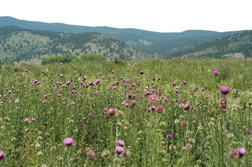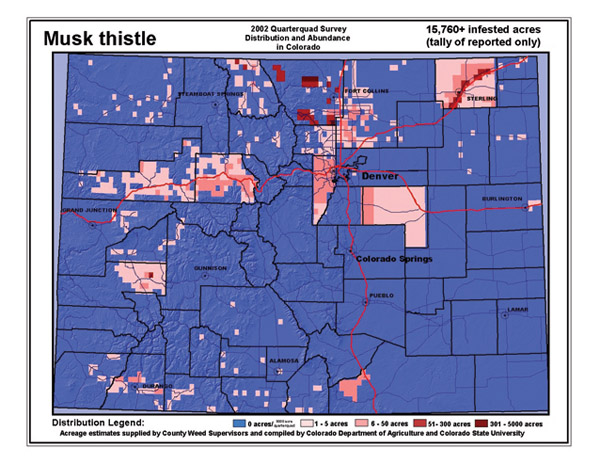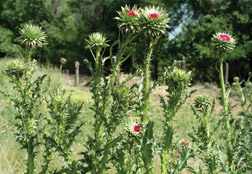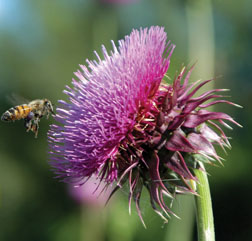by K.G. Beck * (11/13)
Quick Facts…
- Musk thistle is a biennial weed that reproduces only from seed.
- The key to successful musk thistle control is to prevent seed production.
- Apply herbicides such as Tordon, Milestone, Transline, Perspective, Vanquish/Clarity or 2,4-D to musk thistle rosettes in spring or fall. Apply Escort or Telar up to the early flower growth stage.
- Combine control methods into a management system for best results.

Figure 1. Musk thistle infestation in the Colorado foothills. |
Musk thistle is an aggressive weed of foreign origin that occurs in pastures, rangeland, roadsides and non-crop areas (Figure 1). It is a biennial weed, although occasionally it is an annual. Because musk thistle reproduces solely from seed, the key for successful management is to prevent seed production. Over 46,000 acres are infested with musk thistle in Colorado (Figure 2).
Germination and seedling establishment are correlated with moisture and light. Thus, more seeds germinate and establish plants in open pastures and other degraded areas.
Vigorously growing grass competes with musk thistle, and fewer thistles occur in pastures where grazing is deferred. However, musk thistle also can become a problem in pasture or rangeland that is in good condition.

Figure 2. Musk thistle distribution in Colorado, 2009. |
Phenology

Figure 3. Musk thistle rosettes. |
Seedlings normally emerge early in spring, develop into rosettes and spend the first season in this growth stage. Seedling emergence also can occur in fall. All seedlings grow into rosettes and overwinter in that stage. Rosettes are usually large and compact with a large, corky taproot that is hollow near the crown (Figure 3). Leaves have consistent shape, sometimes expressing a frosted appearance around the leaf margins, and often have a cream-colored midrib (Figure 4).
Early in spring of the second year, overwintered rosettes resume growth. Shoots begin to elongate (bolt) in late March through May, depending on weather and elevation (Figure 5). Musk thistle flowers (Figure 6) and starts to produce seed 45 to 55 days after it bolts. Musk thistle has very large bracts beneath flowers that are armed with sharp spines and shoots beneath flowers are almost devoid of leaves.
Musk thistle dies after it sets seed. It spends approximately 90 percent of its life cycle in a vegetative growth stage. Musk thistle’s tolerance to most herbicides increases after it bolts.

Figure 4. Musk thistle leaves; note cream-colored mid-rib and frosted appearance around leaf margins. |

Figure 5. Musk thistle in bud growth stage; note large bracts below developing flower. |
Reproduction and Spread
Musk thistle is a prolific seed producer. One plant can set up to 20,000 seeds. However, only one-third of the seeds are viable. Musk thistle produces many heads. The terminal, or tallest, shoots flower first, then lateral shoots develop in leaf axils. A robust plant may produce 100 or more flowering heads.
Musk thistle flowers over a seven- to nine-week period. It begins to disseminate seed from a head about two weeks after it first blooms. It is common to observe musk thistle with heads in several stages of floral development and senescence. Thus, musk thistle sets seed over an extended time period.
Most seed is dispersed within the immediate vicinity of the parent plant. This leads to a clumped pattern of seedling development and results in intraspecific competition and mortality. Wind and water are good dissemination methods and seeds are also spread by animals, farm machinery and other vehicles. Less than 5 percent of seed remains attached to the pappus when it breaks off the flowering head and floats away on wind currents.
Management
Cultural control. Maintaining pastures and rangeland in good condition is a primary factor for musk thistle management. To favor pasture and rangeland grass growth, do not overgraze. Fertilize only when necessary and according to soil testing recommendations. To successfully manage musk thistle, prevent seed formation.
Mechanical control. Musk thistle will not tolerate tillage and can be removed easily by severing its root below ground with a shovel or hoe. Mowing can effectively reduce seed output if plants are cut when the terminal head is in the late-flowering stage. Gather and burn mowed debris to destroy any seed that has developed.

Figure 6. Musk thistle flower; note large bracts and lack of leaves on shoot below flower. |
Chemical control. Several herbicides are registered in pasture, rangeland and noncrop areas to control musk thistle. Tordon 22K (picloram), Milestone (aminopyralid), Transline (clopyralid), Perspective (aminocyclopyrachlor + chlorsulfuron), Banvel/Vanquish/Clarity (dicamba), 2,4-D, or Banvel/Vanquish/Clarity plus 2,4-D are commonly used. Apply these herbicides in spring or fall to musk thistle rosettes. Refer to Table 1 for rates and application timings and always read the herbicide label before using the product. Applications during the reproductive growth stages with these herbicides (bud through flowering) will not eliminate viable seed development.
Escort (metsulfuron) or Cimarron X-tra (metsulfuron + chlorsulfuron) also can be used in pastures, rangeland, and non-crop areas. Research from Colorado State University and the University of Nebraska shows that chlorsulfuron or metsulfuron prevents or dramatically reduces viable seed formation when applied in spring, up to early flower growth stages. The latest time to apply these herbicides is when developed terminal flowers have opened up to the size of a dime. Add a good agricultural surfactant at 0.25 percent v/v to Escort or Cimarron X-tra treatments or control is inadequate (equivalent to 1 quart of surfactant per 100 gallons of spray solution).
| Table 1. Herbicide rates and application timings to control musk thistle. | |||
| Herbicide | Rate (Product/A) | Application timing |
Comments |
| Tordon | 0.5 to 1 pint | Spring at rosette growth stage; or in fall | Use higher rates for older or dense stands |
| Milestone | 3 to 5 fl oz | Spring at rosette growth stage; or in fall | Use higher rate for older or dense stands; may be used to edge ponds or streams |
| Transline | 0.67 to 1.33 pints | Spring at rosette to early bolting growth stages; or in fall | Use higher rate for older or dense stands |
| Banvel, Vanquish, or Clarity (dicamba) | 1 to 2 pints | Spring rosette growth stage; or in fall | Use higher rate for older or dense stands |
| Perspective | 3 to 4.5 oz | Spring rosette growth stage; or in fall | Use higher rate for older or dense stands |
| Cimarrron X-tra | 0.5 oz | Spring rosette to early bud growth stages; or to fall rosettes | Add non-ionic surfactant at 0.25% v/v |
| Escort | 0.5 oz | Spring to rosette to early bud growth stages; or to fall rosettes | Add non-ionic surfactant at 0.25% v/v |
Biological control. The Colorado Department of Agriculture has established a weevil, Trichosirocalus horridus. This weevil attacks the crown area of musk thistle rosettes and kills or weakens the plant before it bolts. This weevil is being distributed throughout Colorado by the Department of Agriculture. It tends to be more effective than the seed head weevil.
The musk thistle seed head weevil, Rhinocyllus conicus, can be found throughout Colorado. The female deposits her eggs on the back of developing flowers and covers them with chewed leaf tissue. After eggs hatch, larvae bore into the flower and destroy developing seed. The seed head weevil reduces seed production by 50 percent on the average. If used alone, however, it is not an effective management tool. Certain herbicides or mowing can be combined with the seed head weevil if these are used during late flowering stages. This allows the weevils to complete their life cycle and ensures their presence in subsequent growing seasons. The musk thistle seed head weevil is not being redistributed anymore because it attacks many different species of thistles, including native thistles.
Integrating Control Methods
To combine chemical and biological control methods, apply herbicides when they won’t interfere with insect development. That is, allow the control insects to complete their life cycle. Or use herbicides in areas that aren’t sensitive to their use and biological control in areas where herbicides are impractical or environmentally unsafe.
Cultural methods that favor desirable plant growth can be combined with chemical or biological control by superimposing proper grazing management and seeding.
* Colorado State University Extension weed science specialist and professor, bioagricultural sciences and pest management. 9/98. Revised 11/13.
Colorado State University, U.S. Department of Agriculture, and Colorado counties cooperating. CSU Extension programs are available to all without discrimination. No endorsement of products mentioned is intended nor is criticism implied of products not mentioned.
Go to top of this page.





